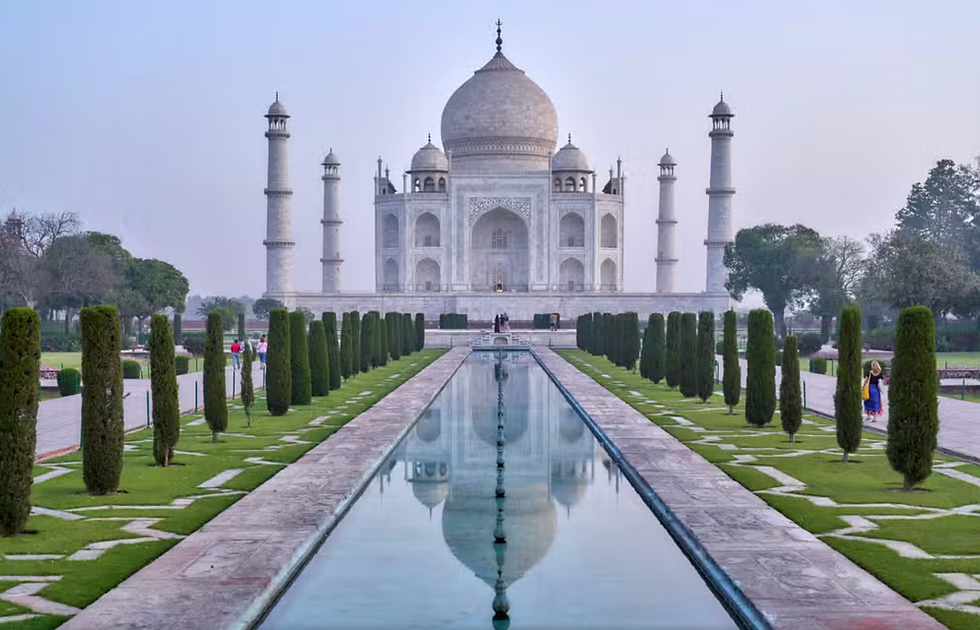India's Remarkable Economic Projection: A Beacon of Growth and Potential
- Sam Golder
- Jul 19, 2023
- 3 min read

Credit: Evening Standard
India, the land of diversity and ancient civilisation, has emerged as a global powerhouse in recent years, showcasing an impressive projection of its economy. With a population of over 1.43 billion people and a rich cultural heritage (Wolf, 2023), India has positioned itself as a major player in the global economic landscape. Through various policy reforms, ambitious infrastructure projects, and a burgeoning entrepreneurial spirit, India has become an attractive investment destination and an engine of growth for the world.
Arguably, India's greatest strengths lies in its young population. India has a large and growing workforce, providing a demographic dividend that can fuel economic growth. By 2020, the average age in India was estimated to be 29 years (Clancy, 2023), significantly lower than that of many developed or developing nations. This youthful workforce brings with it innovation, creativity, and a drive for success, making India a hub for talent and entrepreneurship. While, also allowing for many professionals and workers to be available to encourage further economic expansion.
India is at the forefront of global technology revolution, with a rapidly expanding digital ecosystem. The country has witnessed a significant surge in technology start-ups, especially in sectors such as e-commerce, fintech, and health tech (Stanbury, 2023). Companies like Flipkart and Zomato have not only transformed the Indian market but also gained international recognition. The government's Digital India initiative and the rise in smartphone penetration have further accelerated the digital transformation, opening up new avenues for economic growth and employment.
India's economic projection has been bolstered by a series of structural reforms aimed at creating a favourable business environment. The government's "Make in India" campaign has focused on attracting foreign direct investment (FDI) and encouraging domestic manufacturing. Simplified regulations, reduced bureaucracy, and tax reforms have made it easier for businesses to operate and invest in India. The introduction of the Goods and Services Tax (GST) has streamlined the indirect tax system, promoted a unified market and facilitated interstate trade.

Credit: Goldman Sachs Research India's ambitious infrastructure projects have played a crucial role in protecting its economy as a force to be reckoned with. Initiatives like Bharatmala, Sagarmala, and the Smart Cities Mission have aimed to increase how modern the transportation networks, develop ports and logistics, and build sustainable urban areas. These projects not only enhance connectivity within India but also strengthen trade links with other nations. The development of dedicated freight corridors, expansion of airports, and the focus on renewable energy infrastructure are further indicators of India's commitment to sustainable growth.
India's burgeoning middle class and the rapid growth of consumer spending have made it an attractive market for both domestic and international businesses. As disposable incomes rise, there is a growing demand for a wide range of products and services. Industries such as retail, consumer goods, healthcare, and entertainment are witnessing significant expansion. Multinational corporations are recognizing the potential of the Indian market and are establishing a strong presence to tap into this consumer base.
India has been actively pursuing a green energy transition, positioning itself as a global leader in renewable energy. The government's commitment to the International Solar Alliance and the ambitious target of achieving 450 gigawatts of renewable energy capacity by 2030 demonstrate India's determination to tackle climate change while fostering economic growth (Buckley, 2023). The promotion of solar power, wind energy, and electric mobility not only creates jobs but also reduces dependence on fossil fuels and mitigates environmental challenges.
India's projection of its economy is nothing short of remarkable. With a dynamic demographic advantage, thriving technology sector, investment-friendly reforms, infrastructure development, a rising consumer market, and a focus on green energy transition, India is poised to shape the future of the global economy. However, challenges such as poverty alleviation, skill development, and improving healthcare and education infrastructure remain on the agenda. By leveraging its strengths, addressing key issues, and fostering an inclusive and sustainable growth trajectory, India can continue its upward trajectory and become a beacon of progress on the global stage.
Bibliography
Buckley, T. (2023). India needs a doubling of installs to deliver on PM Modi’s 450 GW by 2030 ambition. Read more at: https://energy.economictimes.indiatimes.com/news/renewable/india-needs-a-doubling-of-installs-to-deliver-on-pm-modis-450-gw-by-2030-ambition/96246672
Stanbury, B. (2023). The Information Technology in India. Read more at: https://www.leap29.com/blog/the-information-technology-industry-in-india#:~:text=The%20Information%20Technology%20Industry%20is,of%20the%20outsourcing%20market%20globally.
Clancy, L. (2023). Key facts as India surpasses China as the world’s most populous country. Read more at: https://www.pewresearch.org/short-reads/2023/02/09/key-facts-as-india-surpasses-china-as-the-worlds-most-populous-country/
Wolf, M. (2023). Western Leaders are Making a Sensible Bet on India. Read more at: https://www.ft.com/indian-economy
By Samuel Golder
Founder and Blogger




Comments